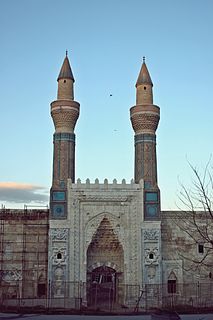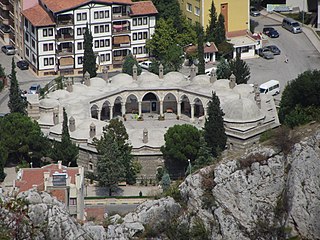The arghul, also spelled argul, arghoul, arghool, argol, or yarghul, is a musical instrument in the reed family. It has been used since Ancient Egyptian times and is still used as a traditional instrument in Egypt and Palestine.

Trabzon Province is a province of Turkey on the Black Sea coast. Located in a strategically important region, Trabzon is one of the oldest trade port cities in Anatolia. Neighbouring provinces are Giresun to the west, Gümüşhane to the southwest, Bayburt to the southeast and Rize to the east. The major ethnic groups are Turks, but the province is also home to a minority of Muslim Pontic Greek speakers, though younger speakers are not always fluent in this language. İsmail Ustaoğlu was appointed the Governor of the province in October 2018.

İnce Minareli Medrese is a 13th-century madrasa located in Konya, Turkey, now housing the Museum of Stone and Wood Art.

Tokat Province is a province in northern Turkey. Its adjacent provinces are Amasya to the northwest, Yozgat to the southwest, Sivas to the southeast, and Ordu to the northeast. Its capital is Tokat, which lies inland of the middle Black Sea region, 422 kilometers from Ankara.

Sivas is a city in central Turkey and the seat of Sivas Province.

Çifte Minareli Medrese is an architectural monument of the late Seljuk period in the Turkish city of Erzurum. Built as a theological school a few years before 1265, it takes its name, Twin Minaret Madrasa, from the two fluted minarets that crown the monumental façade.
Gevher Nesibe was an early 13th century princess of the Sultanate of Rum, the daughter of Kilij Arslan II and sister of Kaykhusraw I.

The Eastern Anatolia Region is a geographical region of Turkey.

Şifaiye Medresesi is a medrese built in 1217 in Sivas, Turkey. It bears typical Seljuk features and was built by the Rûm Seljuk Sultan Kaykaus I, who was known for his fondness for the city of Sivas where he spent the large part of his period of reign.
Fakhr al-Din Ali, better known as Sâhib Ata or Sâhip Ata, held a number of high offices at the court of the Sultanate of Rum from the 1250s until his death in 1288. He was the dominant personality in Anatolia after the death of the Pervane Mu’in al-Din Suleyman in 1277. He established numerous charitable foundations in cities across the Sultanate of Rum.

Koca Mustafa Pasha Mosque is a former Eastern Orthodox church converted into a mosque by the Ottomans, located in Istanbul, Turkey. The church, as the adjoining monastery, was dedicated to Saint Andrew of Crete, and was named Saint Andrew in Krisei or by-the-Judgment. Although heavily transformed during both the Byzantine and the Ottoman eras, it is one among the few churches in Istanbul still extant, whose foundation goes back to the sixth century.

Cifte hammam is a hammam in the Old Bazaar of Skopje, North Macedonia. It was built in the mid-15th century by Bosnian general Isa-Beg Ishaković in order to provide a regular source of income for his endowment.
Seljuk architecture comprises the building traditions used by the Seljuq dynasty, when it ruled most of the Middle East and Anatolia during the 11th to 13th centuries. After the 11th century, the Seljuks of Rum emerged from the Great Seljuk Empire developing their own architecture, though they were influenced and inspired by the Armenian, Byzantine and Persian architectural traditions.

Gökmedrese or Gök Medrese, also known as Sahibiye Medresesi, is a 13th-century medrese, an Islamic educational institution, in Sivas, Turkey.

Büyük Ağa Medresesi or Kapı Ağa Medresesi is a historical 15th century medrese in Amasya, Turkey. The complex was built in 1488 on the order of the Kapı Ağası Hüseyin Ağa during the reign of the Ottoman sultan Bayezid II.
Sahn-ı Seman Medrese or Semâniyye is a 15th-century Ottoman Medrese complex in Istanbul, Turkey, which was part of the Fatih Mosque. It was one of the highest educational facilities of various sciences such as theology, law, medicine, astronomy, physics and mathematics, and was founded by the Turk astronomer Ali Qushji who was invited by the Ottoman sultan Fatih Sultan Mehmed to his court in Istanbul.

Gökmedrese or Gök Medrese, is a 13th-century Anadolu Selçuklu medrese, in Tokat, Turkey. This splendid piece of Seljuk architecture for years hosted the "Tokat Müzesi", an archaeological and ethnographical museum, until that moved in 2012 to a location in the bedesten area.
The Touristic Eastern Express is a scenic passenger train operated by the Turkish State Railways (TCDD). The train runs eastward 1,365 km (848 mi) from Ankara Railway Station to Kars Railway Station. The train service debuted on 29 May 2019 with an official ceremony attended by government ministers. The service was established as an alternative to the regular Eastern Express, which runs the same line but was mostly sold-out weeks in advance in recent years for sightseeing purposes.

Buruciye Medrese or Buruciye Madrasah is a former medrese, in Sivas, Turkey. It was built during the reign of Seljuk sultan Gıyaseddin Keyhüsrev III in 1271.

Çifte Minareli Medrese, literally "Double Minaret Madrasah", is a former medrese located in Sivas, Turkey. It was built in 1271/2. It was commissioned by Şemseddin Cüveynî an Ilkhanid vizier.













